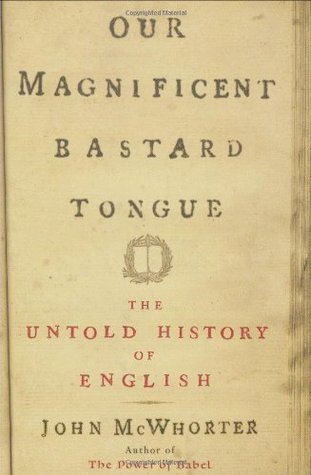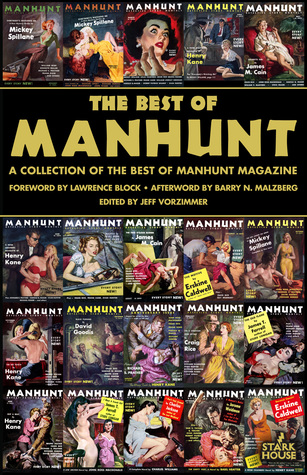Title: Our Magnificent Bastard Tongue
Rating: 3 Stars
I’ve taken a couple of Great Courses taught by the linguist John McWhorter. They were two of my favorite courses. He takes the extremely complex subject of linguistics and makes it accessible. He takes examples from a breathtakingly vast array of languages. Beyond the sheer breadth of his knowledge, he has a dry wit that I find very entertaining. My enjoyment of his lecture series was the impetus for me to try one of his books.
Since the subject was English, the breadth of this book is much narrower than his lecture series. Even so, his lecture style translated quite well to the written word. He still inserts offbeat personal anecdotes for amusement. Although speaking of the development of English, he did manage to insert examples from such languages as Proto Indo-European, Icelandic, German, Old English, Welsh, Old Norse, Cornish, and, believe it or not, Phoenician. That’s not even a close to a complete list.
The book is broken into five essays, some of which are more closely linked than others. He tries to answer two questions. One is rebutting the idea that English as it’s been recently morphing is going downhill. We no longer speak ‘proper’ English and we should feel bad about ourselves for this deficiency. The other (and related question) is how did we get from Old English to Middle English (which put us on the pathway to our current English) anyway?
He has his own ideas regarding how this happened, and in so doing, he kind of takes some shots at other linguistic theories. What he says makes perfect sense and perhaps the shots are justified, but I don’t have a horse in this race. One of the reasons that I didn’t give it a higher rating was because he spent, for me anyway, too much time trying to settle scores with these competing theories. It felt like a little too inside ivory tower office politics.
Be that as it may, it’s an interesting question. How did Old English became Middle English? In some ways the language got more complex while in other ways it got much simpler. Especially compared to other Germanic languages, modern English appears almost streamlined. How did that happen?
Apparently one common theory is to blame the French. They conquered and took over rule of England after the Battle of Hastings in 1066. In the span of about 150 years or so, they had such an influence over the development of the English language that it quickly morphed from Old English to Middle English.
McWhorter has several issues with that. First of all, that’s not nearly enough time for such significant changes to take root across the country. Secondly, the French pretty much kept to themselves. They were an small, insulated, ruling elite. Given the lack of anything approaching mass publishing and the nearly complete illiteracy of the country, even if they wanted, there was no way that they could have effected the change.
What’s misleading the conventional linguists (McWhorter believes) is their reliance upon the written record. It’s understandable why they do so since it’s not like there are audio recordings from the eleventh century. However, relying so heavily upon the written record is misleading because, as I just said, the people were primarily illiterate. Therefore, the people that were writing in Old English all of this time were the educated elite. As the educated elite, they continued to write in Old English even as the language was undergoing evolution.
I just read a history of WWII Japan. In Emperor Hirohito’s speech to the Japanese people where he announced that Japan was surrendering, he spoke in such a high style, royal, archaic dialect that the average Japanese actually had trouble understanding him. When reading Old English, it’s the same thing. What is being written on the page was not what was being said in the village.
In fact, the 150 year or so period of French rule had the effect of dislodging the elite writers of Old English. When English writing started again, it was a new generation of writers emboldened to write in a language closer to what was already being spoken.
So McWhorter’s thesis is that Old English, like every language ever developed, was in a constant state of changes over the centuries. He sees two major events that had the largest impact.
One event brought about what he calls the ‘meaningless do’ and adding the ‘-ing’ present tense to verbs. For example, the question “Do you see what she is writing” is uniquely English. No other Germanic language has the equivalent of the word ‘do’ in this context. What does ‘do’ even do? What is its purpose? Secondly, no other Germanic language adds the -ing suffix to a present tense verb like writing. Languages just don’t randomly do this. How did it happen?
In the 5th Century AD, the Germanic tribes of Angles, Saxons, and Jutes invaded England and basically took over. The current inhabitants, the Celts, were defeated. However, as McWhorter notes, it’s not like they were annihilated. The Celts were still there, living their lives. Not only that, but the Germanic and the Celtic tribes not only coexisted but intermingled. Over the centuries, the Germanic language of Old English was morphed by the Celtic languages of Welsh and Cornish. Interestingly, features of both of these languages, that are virtually unknown in other languages, include the equivalent of the ‘meaningless do’ and adding a suffix to the present tense of verbs.
A second question is regarding the simplicity of English. Along among the other Germanic languages, it is genderless (in fact, it’s about the only such language in Europe). In comparison to the other Germanic languages, its syntax is much simpler. Words like hither, thither, and whither disappeared and here, there, and whether are repurposed. How did this happen?
Starting in about the 9th century AD, the Vikings invaded England. Perhaps in the beginning these were primarily raids. Over time, Vikings came and stayed. They mingled and intermarried. As they did so, these Old Norse speakers were forced to adopt the languages of the much more numerous native inhabitants. As often happens when a group of non-native speakers adopt a new language, the resulting language that is actually spoken has some of its rough edges smoothed off. McWhorter believes that, over the centuries, this Viking influence resulted in a simplified English language.
This brings us to the present. We’re not getting dumber. We’re not getting less precise in our language. Instead, our language, as languages have always done, is undergoing change. Things that seem sacred to the English language will morph over time. Yes, there will be uptight prigs that will clutch their pearls and see in this the inevitable decline of our civilization.
However, I’m pretty sure that we’ll continue to carry on.






